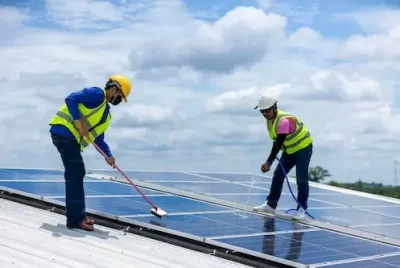Types of Solar Cells, Solar Energy Technology, and Applications
We may earn a commission for purchases made using our links. See our disclosure to learn more.
As the world grows increasingly conscious of its carbon footprint and the need for renewable energy sources, different types of solar cells and solar panels have become viable solutions for sustainable energy generation. These luminous structures, synonymous with a greener tomorrow, capture sunlight and convert it into electricity, thereby serving a host of power needs while reducing reliance on fossil fuels. Let’s delve into the fascinating world of solar panels, examining their types, uses, and pros and cons.
Types of Solar Panels
Solar panels are distinguished mainly based on the type of cell they use in photovoltaic solar power plants. The three primary types of solar cells are Monocrystalline, Polycrystalline, and Thin-Film Solar Cells.
Monocrystalline Solar Panels (Mono-SI)
Monocrystalline types of solar cells are easily identifiable by their dark black hue and rounded edges. The name ‘monocrystalline’ refers to the single-crystal structure of the silicon used in these panels. This homogeneous crystal structure facilitates the unimpeded flow of electrons, resulting in a higher efficiency rate.
Pros
- High Efficiency: Monocrystalline panels have an efficiency rate between 20% and 22% due to the purity of the silicon used. This high efficiency translates into more electricity generation per square foot, making them ideal for space-constrained installations.
- Longevity: These panels have an impressive lifespan and typically come with a 25-year warranty, offering long-term assurance of performance.
- Better Performance in Low-Light Conditions: Monocrystalline panels continue to perform well even in low-light and high-heat conditions compared to other types.
Cons
- Cost: The complex manufacturing process and high silicon purity result in a higher cost compared to other types of solar panels.
- Waste: The production process involves cutting cylindrical ingots to form silicon wafers, which leads to considerable silicon waste.
Polycrystalline Solar Panels (Poly-SI)
Characterized by a blue hue and square shape, Polycrystalline solar panels are created from multiple silicon fragments melted together. This process is less energy-intensive and wasteful than that of Monocrystalline panels.
Pros
- Cost-Effective: Due to a simpler manufacturing process, Polycrystalline panels are less expensive than their Monocrystalline counterparts.
- Less Waste: The process of creating Poly-SI panels involves melting raw silicon, a process that produces less waste compared to the production of Mono-SI panels.
Cons
- Lower Efficiency: Poly-SI panels typically have an efficiency rate between 15% and 17%, which is lower due to the presence of many crystal boundaries that can inhibit electron movement.
- Aesthetics: The blueish hue of Poly-SI panels is considered less aesthetically pleasing by some users.
- Performance: These panels don’t perform as well in high-temperature conditions compared to Mono-SI panels.
Thin-Film Solar Cells (TFSC)
Thin-Film Solar types of solar cells differ from Mono-SI and Poly-SI in terms of their manufacturing process and material composition. These panels are made by placing one or more thin layers of photovoltaic solar power plant material onto a substrate.
Pros
- Cost-Effective: TFSCs are easy to produce and hence, cheaper than crystalline-based solar panels.
- Flexibility: Some types of thin-film solar panels are flexible, allowing for a variety of applications such as curved surfaces and lightweight structures.
Cons
- Lower Efficiency: TFSCs have an efficiency rate of 10-12%, which is significantly lower than both Mono-SI and Poly-SI panels. This implies that they require more space to produce the same amount of power.
- Degradation: Thin-film panels tend to degrade faster over time, reducing their output efficiency.
- Environmental Concern: Some thin-film solar cells, such as Cadmium Telluride (CdTe), can be harmful to the environment if not disposed of correctly.
Applications of Solar Panels
The adaptability and scalability of solar panels make them an ideal choice for a wide array of applications. From single-home installations to enormous solar farms powering whole communities, the scope of solar panels’ use is vast and ever-growing. Here we delve into a more detailed discussion about the specific applications of solar panels, illuminating their functionality in different contexts.
Residential Use
Residential solar installations have surged in popularity over recent years. As people become increasingly aware of the impacts of climate change and seek ways to reduce their carbon footprint, solar panels provide an attractive and eco-friendly solution. Homeowners can use solar panels to generate electricity for their households, thus decreasing their reliance on the conventional power grid.
These installations typically involve mounting solar panels on rooftops where they can maximize sunlight exposure. Some homeowners also opt for ground-mounted systems if they possess ample land. The panels convert sunlight into electricity, which can then be used immediately to power appliances and other household electrical systems.
Excess energy production is not wasted. Depending on local regulations and the specific configuration of the system, surplus power can be stored in a battery system for later use, such as during nighttime hours or cloudy days. Alternatively, it may be fed back into the grid through net metering programs. Net metering allows homeowners to receive credit for the electricity they contribute to the grid, further reducing their utility bills.
Commercial Use
Solar energy is not just for homeowners. Businesses across a wide range of sectors are turning to solar panels as a means to offset their energy consumption and reduce operating costs. Whether it’s a small local business or a large corporation, solar energy offers an effective strategy for long-term sustainability and cost savings.
Commercial solar systems are usually larger than residential ones, designed to meet the higher energy demands of businesses. These solar energy techs are typically installed on the rooftops of commercial buildings or on unused land. They help companies generate their electricity, thus reducing their dependence on the utility grid and protecting against fluctuating energy costs.
Beyond just cost savings, transitioning to solar energy allows businesses to position themselves as environmentally responsible entities. This green image can enhance their reputation among customers and stakeholders who prioritize sustainability.
Utility-Scale Solar Farms
Solar panels are also used in utility-scale solar farms or solar power plants on an even larger scale. These massive installations consist of thousands, sometimes millions, of solar panels and can generate power on the scale of traditional fossil fuel power plants. These types of solar cells significantly add substantial renewable energy capacity to the grid, enough to power many thousands of homes.
These solar farms are often established in areas with high solar irradiance levels, like deserts or other open landscapes. The electricity generated from these installations is fed directly into the power grid and distributed to consumers by utility companies. Utility-scale solar farms represent an essential component in the transition towards more sustainable and renewable energy infrastructures.
Portable Solar
Solar panels come in portable forms at the other end of the scale. Portable solar panels are a favorite among campers, RV owners, boaters, and anyone needing power in remote locations where traditional power sources are unavailable or unreliable. These solar panels are designed to be lightweight, easy to transport, and simple to set up and use.
Portable solar energy tech can power a surprising range of devices, including lights, radios, cell phones, laptops, and even small refrigerators. This application of solar power underscores solar energy technology’s flexibility and the possibility of harnessing the sun’s energy no matter where you are.
You might also like: Best Portable Solar Panels
Solar-Powered Devices
Solar energy technology with different types of solar cells has become so ubiquitous that it’s now integrated into everyday objects. A wide variety of devices now come with solar panels as a primary or supplementary power source. You can find solar panels in garden lights, saving homeowners the trouble of wiring outdoor lights and reducing energy consumption. Solar water heaters provide a cost-effective way to supply hot water to homes.
Other solar-powered devices include chargers, which can recharge devices like cell phones and laptops when traditional power sources are unavailable. Even watches are available with tiny integrated solar panels to keep them running indefinitely.
Bottom Line
In conclusion, solar panels represent an exciting technology with the potential to significantly reduce our reliance on non-renewable energy sources. Understanding the different types of solar cells, solar energy technology, and their pros and cons is crucial to make an informed decision about solar panel installations. As we march towards a greener future, solar energy stands as a beacon of sustainable and clean energy generation.
Read more: Solar Power Knowledge Hub




